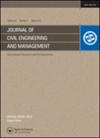APPLYING AI TECHNOLOGY TO RECOGNIZE BIM OBJECTS AND VISIBLE PROPERTIES FOR ACHIEVING AUTOMATED CODE COMPLIANCE CHECKING
IF 3.7
3区 工程技术
Q1 ENGINEERING, CIVIL
引用次数: 1
Abstract
Automated code compliance checking is an effective approach for assessing the quality of building information modeling (BIM) models. Various automated code compliance checking systems have emerged, wherein users need to input all information accurately according to BIM modeling guidelines, in order to ensure the accuracy of checking results. However, as this process involves human inputs, it is difficult to ensure that each input is accurate. In the case of errors or missing inputs, the checking results will be erroneous. Although automated checking systems can be developed accurately, it is difficult to apply these systems practically. Therefore, this paper proposes the application of AI technology to recognize BIM objects and visible properties, in order to improve the operability of automated code compliance checking. The two necessary elements – object names and properties – could be automatically extracted to a certain extent, following the application of the proposed method to the automated code checking process. The error rate of the input could also be reduced, thus making the application of the code checking system more practically feasible. The proposed recognition method for BIM objects and visible properties is also expected to be used widely in BIM-based building e-submission systems and BIM-based forward designs.应用人工智能技术识别bim对象和可见属性,实现自动代码遵从性检查
自动代码符合性检查是评估建筑信息建模(BIM)模型质量的有效方法。各种自动化代码符合性检查系统已经出现,用户需要按照BIM建模指南准确输入所有信息,以确保检查结果的准确性。然而,由于这个过程涉及人工输入,很难确保每个输入都是准确的。如果出现错误或缺少输入,则检查结果将是错误的。虽然可以开发出精确的自动检测系统,但很难在实际中应用。因此,本文提出应用AI技术识别BIM对象和可见属性,以提高自动化代码符合性检查的可操作性。在将建议的方法应用于自动代码检查过程之后,可以在一定程度上自动提取两个必要的元素——对象名称和属性。还可以降低输入的错误率,从而使码检系统的应用更具实际可行性。所提出的BIM对象和可见属性识别方法也有望在基于BIM的建筑电子提交系统和基于BIM的正向设计中得到广泛应用。
本文章由计算机程序翻译,如有差异,请以英文原文为准。
求助全文
约1分钟内获得全文
求助全文
来源期刊

Journal of Civil Engineering and Management
ENGINEERING, CIVIL-
CiteScore
6.70
自引率
4.70%
发文量
0
审稿时长
1.7 months
期刊介绍:
The Journal of Civil Engineering and Management is a peer-reviewed journal that provides an international forum for the dissemination of the latest original research, achievements and developments. We publish for researchers, designers, users and manufacturers in the different fields of civil engineering and management.
The journal publishes original articles that present new information and reviews. Our objective is to provide essential information and new ideas to help improve civil engineering competency, efficiency and productivity in world markets.
The Journal of Civil Engineering and Management publishes articles in the following fields:
building materials and structures,
structural mechanics and physics,
geotechnical engineering,
road and bridge engineering,
urban engineering and economy,
constructions technology, economy and management,
information technologies in construction,
fire protection, thermoinsulation and renovation of buildings,
labour safety in construction.
 求助内容:
求助内容: 应助结果提醒方式:
应助结果提醒方式:


